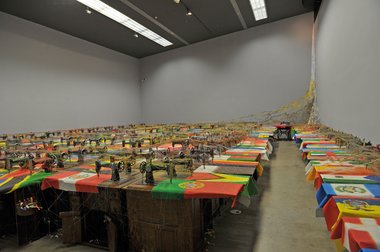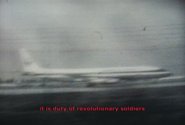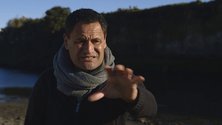Sophie Jerram – 8 August, 2012
Sub-Topical Heat is a collection of nine individually skilled artists, rather than an exhibition whose works are linked in any strong group thematic. It is not practice, politics or medium that links these artists but a post hoc interest in borders, national identity, trade and religion.
New Plymouth
International group show
Sub-Topical Heat: New Art from South Asia
Curated by Rhana Devenport
14 Jul 12 - 4 Nov 2012
In 1977, the Japanese Red Army, a communist revolutionary group, hijacked a Japanese Airline DC8 enroute from Paris to Tokyo. The plane was carrying 156 passengers, including a female New Zealander. Flight 472 was made to land in Dhaka, Bangladesh and the Japanese Government forced to provide $6m and release 9 Red Army prisoners. The hostage negotiations were conducted over six days by the Bangladeshi airport control tower.
Don’t recall this event? You’re not alone, for the event has fallen by the wayside in the history of hostage takings. The incident, in living memory but not commonly recalled, is plucked from collective amnesia by Naeem Mohaiemen’s video work The Young Man Was (Part 1, United Red Army), 2011.
Mohaiemen’s video is the first work we meet in a series of video, installation, painting and interactive pieces in the Govett-Brewster’s gallery-wide Sub-Topical Heat: Art from South Asia. From this point we are bemusedly led into an examination of the exotic and the local, into work that implicates us as much as it informs us. Historical and current events of Bangladesh, Pakistan, India and Sri Lanka are geographically near and yet culturally far. A sense of this near-farness permeates Sub-Topical Heat, making it important viewing for New Zealand audiences with even a passing interest in our Asian neighbours.
Mohaiemen’s video work uses rare archival voice recordings and subtitles, featuring the main hostage taker, ‘Danke’ and the Bangladeshi chief negotiator. The work indicates a deeper history of terrorism in this region than we may have recorded consciously. According to Mohaiemen’s voiceover and wall notes, this event marked the last time that a government willingly negotiated with, and met the terms of, a terrorist group. Since the incident, members of the Red Army are still at large.
The obscurity of the hostage taking has the effect of allowing the audience - confined to a small, darkened room, our own ‘black box’ - to reflect not on the justice of the event but on the emotional states of the hostage-takers and negotiator alike. Like a Shakespearean drama, we get a gripping, close reading of the thought processes and tactics of the chief negotiator, who frequently uses asides to explain his appeal to his terrorist counterpart’s humanity. “Danke, this is your friend,” the chief negotiator restarts the dialogue with at one point. Temporary friends they may have been; we are struck by their need for personal connection in high-stakes deliberations.
Mohaiemen’s photographic contributions, Live True Life, or Die Trying, 2009 examine two Bangladeshi protest groups and indicate a more complacent revolutionary spirit. The name of this group of works comes from a t-shirt worn by one of his subjects. In 2009, the protestors wore a jaded global chic, their calls for action diminished to t-shirt slogans.
The focus of political discontent is further dispersed in the video work of Bani Abidi. Her casual portraits of life in Pakistan belie a serious context. Reserved, 2006 shows a parade on the streets of an unknown city. It reads like a still life survey of the anti-hero, showing an interest in the ankles of the flag wavers to reveal a parade of fallen school socks. This video plays against two other works that we recognise more easily as constructed tableaux. Mangoes, 1999 and The Distance From Here, 2010 are made with the thin quality of daytime soaps, intending to challenge the view of Pakistan as a warring nation, (Abidi’s stated desire) but instead, presenting a softer middle class still infused with a ‘them and us’ mentality.
Borders and peripheries concern Gigi Scaria’s photographs of fabricated structures in grim, periurban landscapes. His works attest to rapid Indian, as well as global, occupation in light of social displacement. “We can be a foreigner in our own country” Scaria notes in his interview with curator Rhana Devenport. (There are good interviews with the Sub Topical Heat artists on the Govett-Brewster website).
Scaria’s metallic floating city, Wind chime, 2012 was made with the help of local Taranaki firm Steel Fab, and suggests a global trade in people alongside the universal need for shelter. Dominating in form, Scaria’s work wreaks a kind of discomfort - demonstrating the need to impress while presenting an edifice-building syndrome.
The work of N.S.Harsha, Nations, is the piece de resistance for Sub Topical Heat, speaking to the messy, tangled threads of a crowded global existence. In this static installation 192 flags of the United Nations are shown being sewn under the needles of 192 sewing machines and a giant cobweb of threads from the flags’ fabric has grown over the machines and into in the corner.
We detect that this is an abandoned project, a historical remnant from the gleeful desire for a cosy globalised world. That N.S.Harsha has sought and found all these historic Singer treadle sewing machines from the Taranaki and Whanganui region is the final triumph of this display of depersonalised, absent labour. By bringing the local machines into his work, he implicates and confuses the history of New Zealand’s colonial past with contemporary Asian sweatshops.
The display of books by collective Raking Leaves is a more delicate high-point in the Govett-Brewster show. These books are not embellished documentation or commentaries on the artists in Sub Topical Heat. Instead for Raking Leaves, it seems books are the ultimate object of discovery; precious portmanteaus of expression and potentially objects of subversion. Inside Bani Abidi’s The Speech Writer, ten flip-page books fit neatly. With memorable poignant stories revolving around an elderly Pakistani man, these books are more discoverable and personal than videos where the pace would be pre-determined by the video-maker not the viewer.
It is, in fact, also easier to enjoy the works of painter Imran Qureshi in book form rather than on the wall. My ability to admire the gestures and details of Moderate Enlightenment is much greater in a gilt-edged, hand sized book than images framed on the gallery wall. Having said that, Qureshi’s use of old school books in homage to the Mughal tradition of painting are striking. We see the violence in the small frame and are reminded of the unacknowledged victims of bomb attacks.
Similarly, the paintings of Nusra Latif Qureshi - female colonial shadow figures painted with reference again to the Mughal miniature tradition - would have been ripe for some other form of more intimate display off the wall. After the busy video and installation works, her beautiful paintings feel a little shy in this exhibition.
On a refreshingly different tack, Indian artist Sharmila Samant has turned her video camera on her New Zealand hosts - the people of Taranaki. She had only 3 weeks before Sub Topical Heat opened, to seek stories to match her interest in water and its scarcity. Brave though this was, she possibly needed more time for reflection and editing in The Wasteland. In her Taranaki residency, Samant interviewed local Maori personalities and elders (Te Huirangi Waikerepuru, Mina Timutimu, Wharehoka Wano, Pounamu Skelton and Glen Skipper) about the spiritual and practical aspects of caring for the region’s water. However, Samant opens her work by citing T.S. Eliot’s The Wasteland - using both a written and spoken soundtrack of T.S.Eliot’s original awkward reading - before handing the content over to the local speakers. It speaks of crossed intentions, for the abundance of water in Taranaki works firmly against Samant’s interest in discussing an impending water crisis. Samant has also applied a tinkly, magical cinematic soundtrack to The Wasteland that makes the movie’s images and speakers exotic. This leaves our local characters somewhat suspended in the realm of the foreign: it doesn’t land.
Her video work Mrigajaal - the Mirage made in India is stronger. In it she tells the fictional story of a blind water diviner, interspersed with images of wasteland India. Using a New Zealand female voiceover immediately connects our plight to that of the Indian girl.
Sheba Chhachhi is an experienced and engaged activist and artist, concerned with aspects of environmental conditions including food sovereignty and water usage. As viewers, we are well rewarded by her interactive work, Bhogi/Rogi (Consumption/Disease), 2010/2011. At first the screen appears to show a looped video work of a field of yellow rape flowers. But if, after following the signage and some urging from gallery staff, we enter the space behind the screen we find ourselves in a room where our image is projected into the field. After a decent pause, the screen changes, taking us with it, shadowing our movements and implicating us in a series of manufacturing processes that eventually re-present our bodies as canned goods. Watching from outside the room, visitors can see ‘their performance’ more passively, yet they are in the room for over 5 minutes - a short time in a manufacturing process but long by gallery watching standards.
In comparison, Sheba Chhachhi’s lightbox works, Edible Birds I, II and III, 2007 are harder to read in a New Zealand context. This may have been due to the saturation of moving image in the gallery, the placement of the boxes in a more peripheral space, or my lack of knowledge about Hindu symbols, but I found it harder to stay entranced with the female figure moving through a slow dreamscape.
Sub-Topical Heat is a collection of nine individually skilled artists, rather than an exhibition whose works are linked in any strong group thematic. It is not practice, politics or medium that links these artists but a post hoc interest in borders, national identity, trade and religion. Some of the work is old and may have been seen before by well-travelled art tourists. Whilst the curatorial ethos for bringing these particular artists together under one roof could be stronger, this collection at the Govett-Brewster is for NZ audiences terrific exposure to work not normally seen in this country. Sub Topical Heat is an important introduction.
Sophie Jerram



 Advertising in this column
Advertising in this column Two Rooms presents a program of residencies and projects
Two Rooms presents a program of residencies and projects
This Discussion has 0 comments.
Comment
Participate
Register to Participate.
Sign in
Sign in to an existing account.